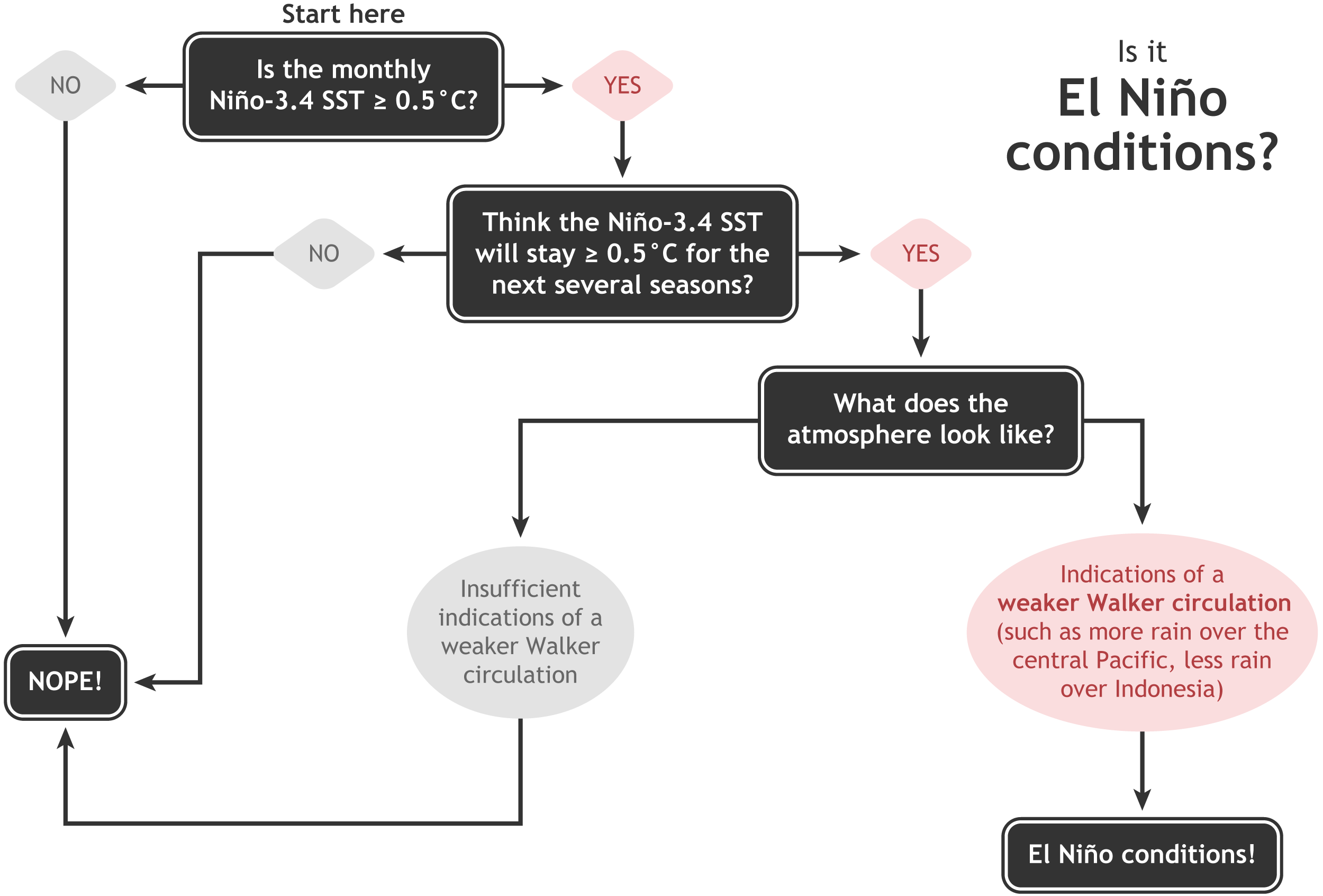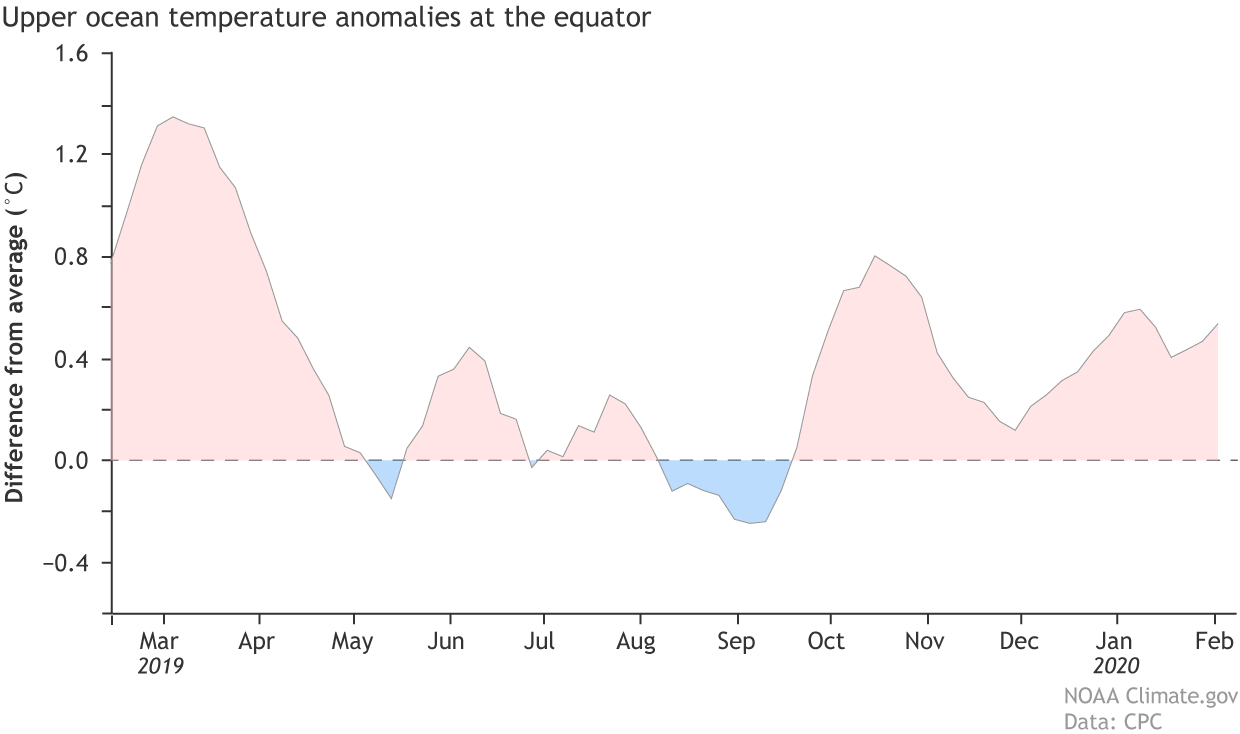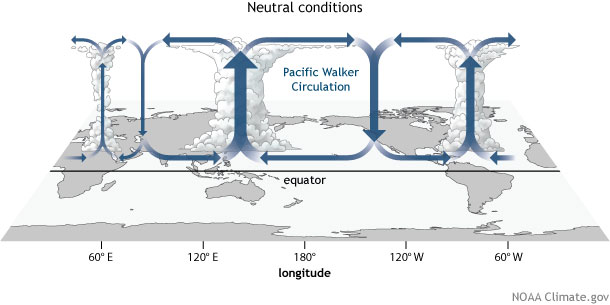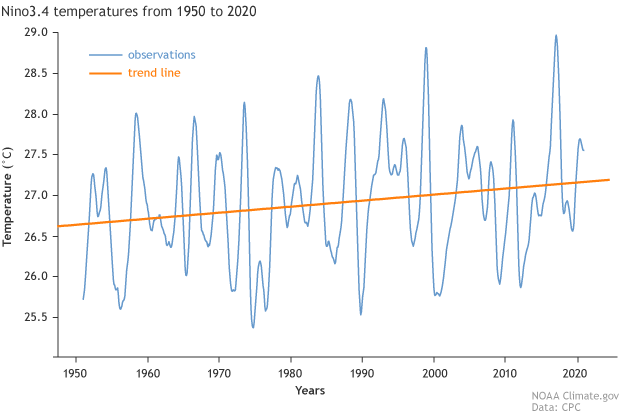February El Nino Update: Mind Reading
Special Stories
14 Feb 2020 2:00 AM
[January 2020 sea surface temperature departure from the 1981-2010 average. Image from Data Snapshots on NOAA Climate]
[NOAA by Emily Becker] The tropical Pacific is warmer than average, but it doesn’t meet El Niño criteria. Forecasters estimate about a 60% chance that ENSO-neutral conditions will continue through the spring, with a 50% chance of neutral through the summer. (ENSO = El Niño/Southern Oscillation, the whole ocean/atmosphere El Niño/La Niña system.)
If you’ve been paying close attention to the sea surface temperatures, you may have noticed that the Oceanic Niño Index, the three-month-average temperature anomaly in the Niño3.4 region, has now been above the El Niño threshold for two consecutive three-month periods, October–December and November–January. (Anomaly = departure from the long-term average.)
The forecast team considered the situation carefully and concluded that the current warmer Pacific Ocean doesn’t reflect El Niño conditions. Also, right now the most likely outcome (60% probability) through the spring is that ENSO will remain in neutral. Perhaps you’re wondering what we were thinking about when we developed our forecasts this month…
 [Summary of decision process in determining El Niño conditions. NOAA Climate drawing by Glen Becker and Fiona Martin.]
Have you ever wondered about the thought process of the ENSO forecaster? I hope so, because today I’ll take you into the mind of one! Well, into the mind of yours truly, since I’m not actually psychic. But, during our team discussions, one can get a pretty good picture of what the ten or so of us are all focusing on. Most of us have been studying the tropical Pacific, looking for clues about ENSO, for years—decades, in some cases—and we still find it interesting and full of surprises.
The first question on my mind each month is about the current conditions in the tropical Pacific Ocean. Do we meet the first criterion for El Niño conditions, as illustrated in our diagnostic flow chart?
The Climate Prediction Center publishes a helpful weekly update on ENSO-related conditions in the ocean and atmosphere. First, I’ll check the Niño3.4 Index, the sea surface temperature in our primary ENSO-monitoring region—it’s been at or above the El Niño threshold (0.5°C above the long-term mean) for the past few months, so we pass the first box.
[Summary of decision process in determining El Niño conditions. NOAA Climate drawing by Glen Becker and Fiona Martin.]
Have you ever wondered about the thought process of the ENSO forecaster? I hope so, because today I’ll take you into the mind of one! Well, into the mind of yours truly, since I’m not actually psychic. But, during our team discussions, one can get a pretty good picture of what the ten or so of us are all focusing on. Most of us have been studying the tropical Pacific, looking for clues about ENSO, for years—decades, in some cases—and we still find it interesting and full of surprises.
The first question on my mind each month is about the current conditions in the tropical Pacific Ocean. Do we meet the first criterion for El Niño conditions, as illustrated in our diagnostic flow chart?
The Climate Prediction Center publishes a helpful weekly update on ENSO-related conditions in the ocean and atmosphere. First, I’ll check the Niño3.4 Index, the sea surface temperature in our primary ENSO-monitoring region—it’s been at or above the El Niño threshold (0.5°C above the long-term mean) for the past few months, so we pass the first box.
 [Area-averaged upper-ocean heat content anomaly (°C) in the equatorial Pacific (5°N-5°S, 180º-100ºW). The heat content anomaly is computed as the departure from the 1981-2010 base period pentad (5-day) means. Heat content increased has been elevated for the last few months. NOAA Climate figure from CPC data.]
Then, to answer the question in the second box, “Think it’ll stay above the threshold for the next several months?” I’ll start with the climate model forecasts. Currently, most of these models are around the threshold for the next few months, but then the anomalies gradually shrink as we go into the spring. To add to the picture of the future of sea surface temperatures in the tropical Pacific, I’ll check on the temperature of the water under the surface of the tropical Pacific.
It’s been above average lately, meaning there’s a source of warmth to supply the surface. It’s not hugely elevated, though—for example, during the weak El Niño last February, the subsurface temperature anomaly was twice as large. Overall, we’re leaning “no” on the second box of the flowchart.
[Area-averaged upper-ocean heat content anomaly (°C) in the equatorial Pacific (5°N-5°S, 180º-100ºW). The heat content anomaly is computed as the departure from the 1981-2010 base period pentad (5-day) means. Heat content increased has been elevated for the last few months. NOAA Climate figure from CPC data.]
Then, to answer the question in the second box, “Think it’ll stay above the threshold for the next several months?” I’ll start with the climate model forecasts. Currently, most of these models are around the threshold for the next few months, but then the anomalies gradually shrink as we go into the spring. To add to the picture of the future of sea surface temperatures in the tropical Pacific, I’ll check on the temperature of the water under the surface of the tropical Pacific.
It’s been above average lately, meaning there’s a source of warmth to supply the surface. It’s not hugely elevated, though—for example, during the weak El Niño last February, the subsurface temperature anomaly was twice as large. Overall, we’re leaning “no” on the second box of the flowchart.
 [Generalized Walker Circulation (December-February) during ENSO-neutral conditions. Convection associated with rising branches of the Walker Circulation is found over the Maritime continent, northern South America, and eastern Africa. NOAA Climate drawing by Fiona Martin.]
To look for changes in the Walker circulation over the past month, I’ll examine the near-surface winds, which were blowing more west-to-east than normal in the western tropical Pacific over the past four weeks. Also, there was a bit more rain than average in the central Pacific. Both of these things can be consistent with El Niño conditions. However, the upper level winds were also more west-to-east than average in the eastern Pacific, which does not match up with El Niño conditions.
Other important measurements of the Walker circulation are the Southern Oscillation Index and the Equatorial Southern Oscillation Index, both of which were close to zero over the past month. Overall, it’s more likely that the near-surface winds and rain patterns were influenced by short-term weather variability recently, not the seasonal pattern that defines ENSO.
[Generalized Walker Circulation (December-February) during ENSO-neutral conditions. Convection associated with rising branches of the Walker Circulation is found over the Maritime continent, northern South America, and eastern Africa. NOAA Climate drawing by Fiona Martin.]
To look for changes in the Walker circulation over the past month, I’ll examine the near-surface winds, which were blowing more west-to-east than normal in the western tropical Pacific over the past four weeks. Also, there was a bit more rain than average in the central Pacific. Both of these things can be consistent with El Niño conditions. However, the upper level winds were also more west-to-east than average in the eastern Pacific, which does not match up with El Niño conditions.
Other important measurements of the Walker circulation are the Southern Oscillation Index and the Equatorial Southern Oscillation Index, both of which were close to zero over the past month. Overall, it’s more likely that the near-surface winds and rain patterns were influenced by short-term weather variability recently, not the seasonal pattern that defines ENSO.
 [Temperature in the Niño3.4 region (5°S - 5°N latitude, 170°W – 120°W longitude) since 1950, using ERSSTv5 data. A 12-point running average has been applied to the monthly temperatures. Orange line shows the 1950 – 2020 trend. NOAA Climate graphic from CPC data.]
When computing Niño3.4 anomalies, we use an averaging period of the most recent 30-year period, updated every five years, to adjust to some of this warming trend. Right now, that averaging period is 1986–2015. Next year, we’ll update to 1991–2020. I’m running out of space to get into the hows and whys of this, but Climate.gov has a nice description here. Overall, though, the climate is warming rapidly, and that can have some effect on ENSO, particularly when we are getting close to updating the averaging period.
[Temperature in the Niño3.4 region (5°S - 5°N latitude, 170°W – 120°W longitude) since 1950, using ERSSTv5 data. A 12-point running average has been applied to the monthly temperatures. Orange line shows the 1950 – 2020 trend. NOAA Climate graphic from CPC data.]
When computing Niño3.4 anomalies, we use an averaging period of the most recent 30-year period, updated every five years, to adjust to some of this warming trend. Right now, that averaging period is 1986–2015. Next year, we’ll update to 1991–2020. I’m running out of space to get into the hows and whys of this, but Climate.gov has a nice description here. Overall, though, the climate is warming rapidly, and that can have some effect on ENSO, particularly when we are getting close to updating the averaging period.
You read my mind
 [Summary of decision process in determining El Niño conditions. NOAA Climate drawing by Glen Becker and Fiona Martin.]
Have you ever wondered about the thought process of the ENSO forecaster? I hope so, because today I’ll take you into the mind of one! Well, into the mind of yours truly, since I’m not actually psychic. But, during our team discussions, one can get a pretty good picture of what the ten or so of us are all focusing on. Most of us have been studying the tropical Pacific, looking for clues about ENSO, for years—decades, in some cases—and we still find it interesting and full of surprises.
The first question on my mind each month is about the current conditions in the tropical Pacific Ocean. Do we meet the first criterion for El Niño conditions, as illustrated in our diagnostic flow chart?
The Climate Prediction Center publishes a helpful weekly update on ENSO-related conditions in the ocean and atmosphere. First, I’ll check the Niño3.4 Index, the sea surface temperature in our primary ENSO-monitoring region—it’s been at or above the El Niño threshold (0.5°C above the long-term mean) for the past few months, so we pass the first box.
[Summary of decision process in determining El Niño conditions. NOAA Climate drawing by Glen Becker and Fiona Martin.]
Have you ever wondered about the thought process of the ENSO forecaster? I hope so, because today I’ll take you into the mind of one! Well, into the mind of yours truly, since I’m not actually psychic. But, during our team discussions, one can get a pretty good picture of what the ten or so of us are all focusing on. Most of us have been studying the tropical Pacific, looking for clues about ENSO, for years—decades, in some cases—and we still find it interesting and full of surprises.
The first question on my mind each month is about the current conditions in the tropical Pacific Ocean. Do we meet the first criterion for El Niño conditions, as illustrated in our diagnostic flow chart?
The Climate Prediction Center publishes a helpful weekly update on ENSO-related conditions in the ocean and atmosphere. First, I’ll check the Niño3.4 Index, the sea surface temperature in our primary ENSO-monitoring region—it’s been at or above the El Niño threshold (0.5°C above the long-term mean) for the past few months, so we pass the first box.
 [Area-averaged upper-ocean heat content anomaly (°C) in the equatorial Pacific (5°N-5°S, 180º-100ºW). The heat content anomaly is computed as the departure from the 1981-2010 base period pentad (5-day) means. Heat content increased has been elevated for the last few months. NOAA Climate figure from CPC data.]
Then, to answer the question in the second box, “Think it’ll stay above the threshold for the next several months?” I’ll start with the climate model forecasts. Currently, most of these models are around the threshold for the next few months, but then the anomalies gradually shrink as we go into the spring. To add to the picture of the future of sea surface temperatures in the tropical Pacific, I’ll check on the temperature of the water under the surface of the tropical Pacific.
It’s been above average lately, meaning there’s a source of warmth to supply the surface. It’s not hugely elevated, though—for example, during the weak El Niño last February, the subsurface temperature anomaly was twice as large. Overall, we’re leaning “no” on the second box of the flowchart.
[Area-averaged upper-ocean heat content anomaly (°C) in the equatorial Pacific (5°N-5°S, 180º-100ºW). The heat content anomaly is computed as the departure from the 1981-2010 base period pentad (5-day) means. Heat content increased has been elevated for the last few months. NOAA Climate figure from CPC data.]
Then, to answer the question in the second box, “Think it’ll stay above the threshold for the next several months?” I’ll start with the climate model forecasts. Currently, most of these models are around the threshold for the next few months, but then the anomalies gradually shrink as we go into the spring. To add to the picture of the future of sea surface temperatures in the tropical Pacific, I’ll check on the temperature of the water under the surface of the tropical Pacific.
It’s been above average lately, meaning there’s a source of warmth to supply the surface. It’s not hugely elevated, though—for example, during the weak El Niño last February, the subsurface temperature anomaly was twice as large. Overall, we’re leaning “no” on the second box of the flowchart.
Head in the clouds
Then I’m on to examining the atmospheric conditions, asking if there are any patterns in the winds or rain that suggest the atmosphere is responding to changes in the ocean surface temperature. Typically, air rises over the very warm water of the far western Pacific, around Indonesia, travels to the east high up in the atmosphere, descends in the eastern Pacific, and travels back west near the surface. This is the Walker circulation, as elegantly discussed by Tom lo these many moons ago. [Generalized Walker Circulation (December-February) during ENSO-neutral conditions. Convection associated with rising branches of the Walker Circulation is found over the Maritime continent, northern South America, and eastern Africa. NOAA Climate drawing by Fiona Martin.]
To look for changes in the Walker circulation over the past month, I’ll examine the near-surface winds, which were blowing more west-to-east than normal in the western tropical Pacific over the past four weeks. Also, there was a bit more rain than average in the central Pacific. Both of these things can be consistent with El Niño conditions. However, the upper level winds were also more west-to-east than average in the eastern Pacific, which does not match up with El Niño conditions.
Other important measurements of the Walker circulation are the Southern Oscillation Index and the Equatorial Southern Oscillation Index, both of which were close to zero over the past month. Overall, it’s more likely that the near-surface winds and rain patterns were influenced by short-term weather variability recently, not the seasonal pattern that defines ENSO.
[Generalized Walker Circulation (December-February) during ENSO-neutral conditions. Convection associated with rising branches of the Walker Circulation is found over the Maritime continent, northern South America, and eastern Africa. NOAA Climate drawing by Fiona Martin.]
To look for changes in the Walker circulation over the past month, I’ll examine the near-surface winds, which were blowing more west-to-east than normal in the western tropical Pacific over the past four weeks. Also, there was a bit more rain than average in the central Pacific. Both of these things can be consistent with El Niño conditions. However, the upper level winds were also more west-to-east than average in the eastern Pacific, which does not match up with El Niño conditions.
Other important measurements of the Walker circulation are the Southern Oscillation Index and the Equatorial Southern Oscillation Index, both of which were close to zero over the past month. Overall, it’s more likely that the near-surface winds and rain patterns were influenced by short-term weather variability recently, not the seasonal pattern that defines ENSO.
Brain waves
What else might contribute to warmer-than-average surface water in the tropical Pacific? Global warming and climate change due to human emissions of greenhouse gases is always on our minds, of course. The average temperature of the Niño3.4 region has increased by more than 0.5°C since 1950. [Temperature in the Niño3.4 region (5°S - 5°N latitude, 170°W – 120°W longitude) since 1950, using ERSSTv5 data. A 12-point running average has been applied to the monthly temperatures. Orange line shows the 1950 – 2020 trend. NOAA Climate graphic from CPC data.]
When computing Niño3.4 anomalies, we use an averaging period of the most recent 30-year period, updated every five years, to adjust to some of this warming trend. Right now, that averaging period is 1986–2015. Next year, we’ll update to 1991–2020. I’m running out of space to get into the hows and whys of this, but Climate.gov has a nice description here. Overall, though, the climate is warming rapidly, and that can have some effect on ENSO, particularly when we are getting close to updating the averaging period.
[Temperature in the Niño3.4 region (5°S - 5°N latitude, 170°W – 120°W longitude) since 1950, using ERSSTv5 data. A 12-point running average has been applied to the monthly temperatures. Orange line shows the 1950 – 2020 trend. NOAA Climate graphic from CPC data.]
When computing Niño3.4 anomalies, we use an averaging period of the most recent 30-year period, updated every five years, to adjust to some of this warming trend. Right now, that averaging period is 1986–2015. Next year, we’ll update to 1991–2020. I’m running out of space to get into the hows and whys of this, but Climate.gov has a nice description here. Overall, though, the climate is warming rapidly, and that can have some effect on ENSO, particularly when we are getting close to updating the averaging period.
All Weather News
More